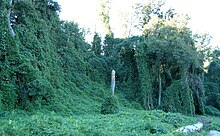Kudzu in the United States: Difference between revisions
split from Kudzu |
(No difference)
|
Revision as of 05:44, 23 July 2010

Kudzu is a serious invasive plant in the United States. It has been spreading in the southern U.S. at the rate of 150,000 acres (61,000 ha) annually, "easily outpacing the use of herbicide spraying and mowing, as well increasing the costs of these controls by $6 million annually."[1] Its introduction has produced devastating environmental consequences.[2]
Kudzu was introduced from Japan into the United States in 1876 at the Philadelphia Centennial Exposition, where it was promoted as a forage crop and an ornamental plant. From 1935 to the early 1950s, the Soil Conservation Service encouraged farmers in the southeastern United States to plant kudzu to reduce soil erosion as explained above. The Civilian Conservation Corps planted it widely for many years.
It was subsequently discovered that the southeastern US has near-perfect conditions for kudzu to grow out of control — hot, humid summers, frequent rainfall, temperate winters with few hard freezes (kudzu cannot tolerate low freezing temperatures that bring the frost line down through its entire root system, a rare occurrence in this region), and no natural predators. As such, the once-promoted plant was named a pest weed by the United States Department of Agriculture in 1953.

Kudzu is now common throughout most of the southeastern United States, and has been found as far northeast as Paterson, New Jersey, in 30 Illinois counties including as far north as Evanston,[3] and as far south as Key West, Florida.[citation needed] It has also been found growing in Clackamas County, Oregon in 2000 with no known source. This is the first infestation west of Texas.[4] Kudzu has naturalized into about 20,000 to 30,000 square kilometers (7,700–11,600 sq mi) of land in the United States and costs around $500 million annually in lost cropland and control costs.[5]
Since 1998, the United States Department of Agriculture, Agricultural Research Service (ARS) has experimented with using the fungus Myrothecium verrucaria as a biologically-based herbicide against kudzu.[1]
See also
References
Part of this article[specify] was based on content from public domain web pages from the United States National Park Service and the United States Bureau of Land Management
- ^ a b "Controlling Kudzu With Naturally Occurring Fungus". ScienceDaily. July 20, 2009. Retrieved 2009-07-20.
- ^ Richard J. Blaustein (2001). "Kudzu's invasion into Southern United States life and culture" (PDF). United States Department of Agriculture. Retrieved August 20, 2007.
- ^ Molly McElroy (2005). "Fast-growing kudzu making inroads in Illinois, authorities warn". News Bureau, University of Illinois at Urbana-Champaign. Retrieved April 28, 2008.
- ^ Oregon Department of Agriculture (2000). "Serious noxious weed found in Oregon for first time". Internet Archive, The. Retrieved August 20, 2007.
- ^ "Cogon Grass Becoming Scourge of the South". Associated Press. October 20, 2003. Retrieved 2008-12-07.
External links
- Species Profile - Kudzu, National Invasive Species Information Center, National Agricultural Library
- Kudzu from the U.S. National Park Service website
- Kudzu in Georgia from the New Georgia Encyclopedia
- Pesky vine is invading southern West Virginia, an August 2006 article from The Register-Herald of West Virginia
